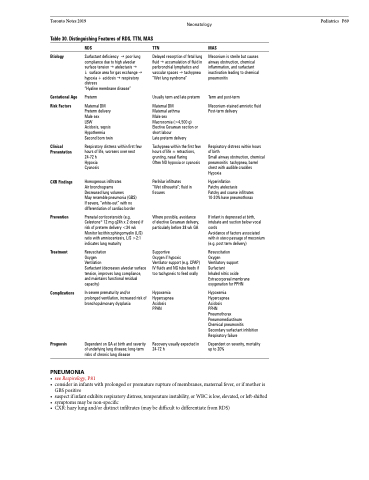Page 1103 - TNFlipTest
P. 1103
Toronto Notes 2019 Neonatology Pediatrics P69 Table 30. Distinguishing Features of RDS, TTN, MAS
RDS
Surfactant deficiency g poor lung compliance due to high alveolar surface tensiongatelectasisg i surface area for gas exchange g hypoxia + acidosis g respiratory distress
“Hyaline membrane disease” Preterm
Maternal DM Preterm delivery Male sex
LBW
Acidosis, sepsis Hypothermia Second born twin
Respiratory distress within first few hours of life, worsens over next 24-72 h
Hypoxia
Cyanosis
Homogenous infiltrates
Air bronchograms
Decreased lung volumes
May resemble pneumonia (GBS) If severe, “white-out” with no differentiation of cardiac border
Prenatal corticosteroids (e.g. Celestone® 12 mg q24h x 2 doses) if risk of preterm delivery <34 wk Monitor lecithin:sphingomyelin (L/S) ratio with amniocentesis, L/S >2:1 indicates lung maturity
Resuscitation
Oxygen
Ventilation
Surfactant (decreases alveolar surface tension, improves lung compliance, and maintains functional residual capacity)
In severe prematurity and/or prolonged ventilation, increased risk of bronchopulmonary dysplasia
Dependent on GA at birth and severity of underlying lung disease; long-term risks of chronic lung disease
PNEUMONIA
TTN
Delayed resorption of fetal lung fluidgaccumulation of fluid in peribronchial lymphatics and vascular spacesgtachypnea “Wet lung syndrome”
Usually term and late preterm
Maternal DM
Maternal asthma
Male sex
Macrosomia (>4,500 g) Elective Cesarean section or short labour
Late preterm delivery
Tachypnea within the first few hours of life ± retractions, grunting, nasal flaring
Often NO hypoxia or cyanosis
Perihilar infiltrates
“Wet silhouette”; fluid in fissures
Where possible, avoidance of elective Cesarean delivery, particularly before 38 wk GA
Supportive
Oxygen if hypoxic
Ventilator support (e.g. CPAP) IV fluids and NG tube feeds if too tachypneic to feed orally
Hypoxemia Hypercapnea Acidosis PPHN
Recovery usually expected in 24-72 h
MAS
Meconium is sterile but causes airway obstruction, chemical inflammation, and surfactant inactivation leading to chemical pneumonitis
Term and post-term
Meconium-stained amniotic fluid Post-term delivery
Respiratory distress within hours of birth
Small airway obstruction, chemical pneumonitis tachypnea, barrel chest with audible crackles Hypoxia
Hyperinflation
Patchy atelectasis
Patchy and coarse infiltrates 10-20% have pneumothorax
If infant is depressed at birth, intubate and suction below vocal cords
Avoidance of factors associated with in utero passage of meconium (e.g. post term delivery)
Resuscitation Oxygen Ventilatory support Surfactant
Inhaled nitric oxide Extracorporeal membrane oxygenation for PPHN
Hypoxemia
Hypercapnea
Acidosis
PPHN
Pneumothorax Pneumomediastinum
Chemical pneumonitis Secondary surfactant inhibition Respiratory failure
Dependent on severity, mortality up to 20%
Etiology
Gestational Age Risk Factors
Clinical Presentation
CXR Findings
Prevention
Treatment
Complications
Prognosis
• seeRespirology,P81
• considerininfantswithprolongedorprematureruptureofmembranes,maternalfever,orifmotheris
GBS positive
• suspectifinfantexhibitsrespiratorydistress,temperatureinstability,orWBCislow,elevated,orleft-shifted
• symptomsmaybenon-specific
• CXR:hazylungand/ordistinctinfiltrates(maybedifficulttodifferentiatefromRDS)


